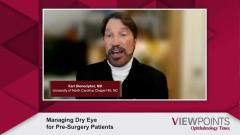
Anti-Inflammatory Therapies for Dry Eye
Ophthalmologists provide an overview of current anti-inflammatory agents available for dry eye disease and how they utilize these therapies for particular patient populations.
Episodes in this series

Transcript
Marguerite McDonald, MD, FACS: Let’s talk about controlling inflammation. This is an essential goal in the long-term management of any [patient with] dry eye. Let’s talk about our experiences with the anti-inflammatory therapies for dry eye, [such as] cyclosporine [Cequa and Restasis], lifitegrast [Xiidra], and loteprednol [Eysuvis]. What are your thoughts? Have you had success with any or all these agents?
Karl Stonecipher, MD: Peter, [do] you want to go first?
Peter McDonnell, MD: Sure. In the early days, a lot of [patients with] dry eye were miserable, but their eyes really did not look inflamed. I think we underappreciated the role of inflammation. Then, thanks to people like Stephen Pflugfelder, [MD], and others, we learned that often there is this T-cell–mediated condition. One of the companies came out with the first topical cyclosporine, and people thought it probably wasn’t going to do anything. It turned into a blockbuster; Restasis [has more than] $1 billion a year in sales. It was life-changing for some patients. At least from my experience, it takes a while to have effect. And it works in a subset of patients; not always…has it been possible to predict what patients will respond to it. But for many patients…they feel it turned out to be life-changing. So, I have used it a fair amount. I let people know it’s not one of these things [where] they use it for a day or 2 and they’ll be cured. They have to be willing to continue with therapy for weeks to months before we’ll know what the effect will be. But there’s no question that a lot of these patients have a substantial underlying inflammatory basis for their dry eye. And these anti-inflammatory, immunomodulatory agents can be very helpful.
Karl Stonecipher, MD: Marguerite and I have been around the block together, because I started working with you back in 1985. That was awhile back; I know we were very young…. You guys used to talk about the stuff you were seeing in the veterinary journals. I [couldn’t] even believe you guys [were] reading the veterinary journals. To bring it full circle, one of the funniest moments I had was John Shepherd—who I respect his opinion in [this] field hugely—was even saying, “I still have to use something like a loteprednol product to try to quell inflammation.” Then like Peter was pointing out, it takes a little while for these things to kick in.
I think the patient comes to us with an acute problem but a chronic condition, so we’ve got to treat the acute problem. If we don’t, they’re going to go elsewhere and say, “That doctor did nothing to make my eyes feel better.” So, I still think that the acutes—and that’s the way I describe it today—I talk [say to patients], “We’re going to treat you acutely with a drop that you can’t use. You can pulse that drop. Then we’re going to put you on a chronic agent. We’re going to see [whether] that works for you.” And as Peter pointed out, it worked very well for a large majority of the population. But I think what we found is [that] inflammation is still a key role, whether we look at evaporative, aqueous deficient, or mixed combination. I think we still have to quiet the inflammation whenever the disease starts.
Marguerite McDonald, MD, FACS: I 100 % agree, that even if you have patients who are beautifully controlled on the anti-inflammatory agents, they’re going to have flare-ups. And when they have a flare-up, you have to use the steroid and caution them about abuse of the steroid, no refills, etc. That’s the only way to keep them comfortable and functional.
Peter McDonnell, MD: Yeah, I think you’re right. The risk is always the patients [who] get lost to follow-up, take the steroid longer than they should, and aren’t getting their pressures checked. But particularly for patients [whom] you have [a] good relationship [with]—because they’re part of your practice, they trust you, and you know they won’t disobey the rules—the steroids for relatively short periods of time can really be helpful in tampering down the short-term flare-ups.
Karl Stonecipher, MD: Primarily in the late to mid-90s, I had the opportunity to start working with anti-inflammatories that promoted healing. The first one was cyclosporine, [and] the second was lifitegrast. We now have 2 products of cyclosporine: Cequa and Restasis. I have to admit, I was part of those clinical trials. I did work with Allergan, and I continued to research with them. But at the same time, we have other options like loteprednol and other things we use today in terms of products for trying to reduce or quiet the inflammation.… We stand on the shoulders of giants like Stephen Pflugfelder and others who really showed us the way that inflammation is part of the process, and we’re still using a lot of those products today.
Marguerite McDonald, MD, FACS: Cyclosporine [and] lifitegrast work. There are differences, of course, from the 10,000-ft view of them, but they’re highly effective. [In the real world,] it comes down to what is covered on the patient’s insurance. That has a major impact. I’m super happy when I’m able to get them on one of these anti-inflammatory agents [and] it’s covered by their insurance. And of course, loteprednol short-term for the occasional flare-up, which occurs even in patients who are very well controlled for the most part.
Karl Stonecipher, MD: And to say something on top of what Marguerite just said, every day—her name’s Chelsea, [for example]—she is working on generics, or lifitegrast, or cyclosporine for different angles. And we have to work through (electronic medical record) EMR now to try to figure out what’s best for the patient, because sometimes they may come back with a $1200 bill or co-pay…. But at the same time, [we just can’t use] some of these products because they can’t afford them. They’re not accessible through our current health care system. So, we can work around that. Marguerite, you have several work-arounds you do to try [to] help those patients, whether they’re over-the-counter [OTC] products or things we can do in the clinic.
Marguerite McDonald, MD, FACS: Absolutely. There are some wonderful [OTC] products. But we have full-time employees now who do nothing but [prior authorization], work with insurance companies—and it’s exhausting and we shouldn’t have to do it. Maybe someday that will change. But you’re correct, there are better [OTC] products that can help in the situation where the patient gets nothing—no prescription drop for dry eye that would be covered on their insurance.
Karl Stonecipher, MD: Peter mentioned earlier the [patients with] Sjögren [syndrome]; my mother-in-law [has] Sjögren [syndrome]. We’ve tried lifitegrast, cyclosporine, and a lot of products these patients can’t take. She’s now using an [OTC], pretty plain-Jane tear product. Then we pulse her with a steroid. Usually around the time that the flowers come out, we pulse her with the loteprednol. We usually pulse her around the ragweed season, which is September/October for us in North Carolina, and then around the Christmas tree season. She does well with that. But we use some of these other ancillary items [such as] low-level light therapy—not so much IPL [intense pulsed light] on a [patient with] Sjögren [syndrome]—but other things, like these heated eye masks, are [also] options for them.
Peter McDonnell, MD: One point [that] might be helpful to mention is, when it comes to anti-inflammatory agents and dry eye—I forget how many years ago—there was quite a flurry of reports in the literature about corneal melting and ulceration with nonsteroidals at the time of cataract or potentially refractive surgery in [patients with] dry eye, [as well as] a suggestion that the surface of a dry eye is a compromised surface and that, as a class of drugs, nonsteroidals might not be well tolerated and patients might be at risk for epithelial defects and ulceration if they have untreated dry eye preoperatively. I think that’s another reason to make sure we recognize and attend to improving the aqua surface and [patients with] dry eye preoperatively. But it’s also given me a lot of respect for use of anti-inflammatory agents like nonsteroidals in [patients with] dry eye.
Transcript was AI-generated and edited for clarity.
Newsletter
Don’t miss out—get Ophthalmology Times updates on the latest clinical advancements and expert interviews, straight to your inbox.















































